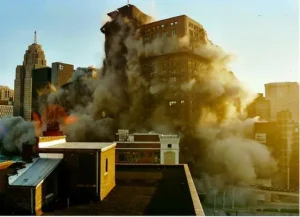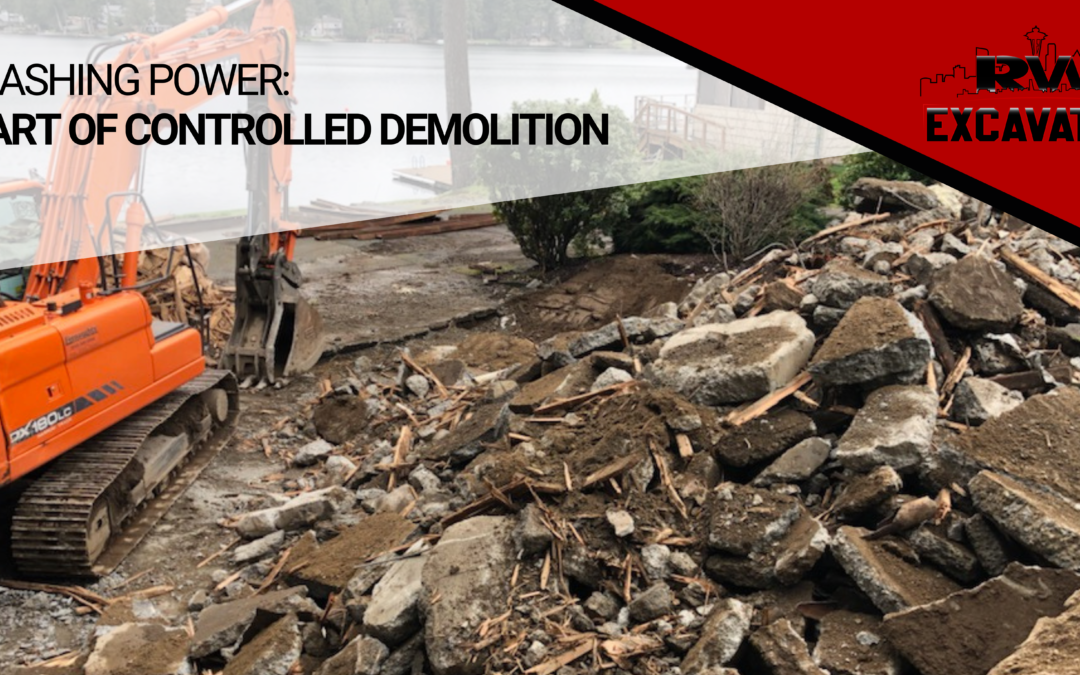In the world of construction and engineering, controlled demolition is an art form that requires precision, expertise, and careful planning. It is the process of strategically dismantling a structure with minimal disruption to the surrounding environment. From towering skyscrapers to massive industrial complexes, controlled demolition is an efficient and cost-effective way to make way for new developments.
The power of controlled demolition lies in its ability to bring down massive structures with controlled explosions and careful timing. It is a highly specialized field that requires a deep understanding of engineering principles, materials science, and safety protocols. Skilled demolition teams meticulously design each demolition project, considering factors such as the structural integrity of the building, environmental impact, and public safety.
In this article, we will delve into the fascinating world of controlled demolition, exploring the techniques, equipment, and expertise involved in the process. Whether you’re a construction enthusiast or simply curious about the engineering behind the destruction, join us as we uncover the art of controlled demolition and the power it holds in shaping our urban landscapes.
The importance of controlled demolition in construction projects
Controlled demolition plays a vital role in the construction industry. It allows for the safe and efficient removal of old or unwanted structures, making way for new developments. Whether it’s a high-rise building in need of renovation or a factory that has become obsolete, controlled demolition offers a practical solution. By carefully planning and executing the demolition process, construction projects can proceed smoothly, avoiding unnecessary delays and minimizing risks.
One of the key advantages of controlled demolition is its ability to minimize the impact on the surrounding environment. Skilled demolition teams carefully analyze the structural integrity of the building and plan the demolition process accordingly. This ensures that surrounding structures, utilities, and natural resources are protected during the demolition. By minimizing the disruption to the environment, controlled demolition allows for a more sustainable approach to construction.
The history and evolution of controlled demolition techniques
Controlled demolition techniques have evolved significantly over the years. In the early days, demolition was often a brute force process, relying on heavy machinery and sheer force to bring down structures. However, as the field of engineering advanced, so did the techniques used in controlled demolition.
The use of explosives revolutionized the demolition industry. Skilled demolition teams started using controlled explosions to strategically weaken the structure and bring it down in a controlled manner. This technique allowed for greater precision and minimized the risk of collateral damage. Over time, advancements in materials science and engineering principles further refined the demolition techniques, making them more efficient and effective.
The science behind controlled demolition
Controlled demolition is not simply a matter of blowing things up. It is a highly scientific process that involves a deep understanding of the physics and mechanics of structures. Skilled demolition teams analyze the structure to be demolished, taking into account factors such as load-bearing walls, structural elements, and weak points. By identifying these key aspects, they can strategically plan the demolition process to ensure a safe and controlled collapse.
Explosives play a crucial role in controlled demolition. By strategically placing explosives at specific points in the structure, demolition teams can weaken the integrity of the building and control the direction of the collapse. Timing is also critical in controlled demolition. The explosives must be detonated in a precise sequence to ensure a controlled and safe collapse. This requires meticulous planning and coordination between the demolition team members.
Safety measures in controlled demolition
Safety is paramount in controlled demolition. Demolition teams follow strict safety protocols to protect both the workers and the surrounding environment. Before any demolition project begins, a thorough assessment of the site is conducted to identify potential hazards and develop mitigation strategies. Protective measures such as safety barriers, scaffolding, and personal protective equipment are put in place to minimize risks.
Training and expertise are also essential in ensuring a safe demolition process. Skilled demolition teams undergo rigorous training to understand the intricacies of controlled demolition. They are well-versed in safety procedures, emergency response protocols, and the handling of explosives. Regular inspections and quality control measures are implemented throughout the demolition project to maintain the highest standards of safety.
Tools and equipment used
Controlled demolition requires specialized tools and equipment to carry out the process efficiently and safely. Heavy machinery such as excavators, cranes, and bulldozers are commonly used to remove debris and support the demolition process. Demolition-specific attachments, such as shears and pulverizers, are used to break down materials and make them more manageable for removal.
Explosives and detonation equipment are crucial components of controlled demolition. Demolition teams work closely with explosives experts to determine the type and amount of explosives needed for each project. Specialized detonation systems are used to ensure precise timing and controlled explosions. Advanced monitoring equipment, such as seismographs, is also employed to measure the impact of the demolition on the surrounding environment.
Steps involved
A controlled demolition project involves several key steps to ensure a successful and safe demolition. The process begins with a comprehensive assessment of the structure to be demolished. Skilled engineers and demolition experts evaluate the structural integrity, materials used, and potential hazards.
Once the assessment is complete, a detailed demolition plan is developed. This plan outlines the sequence of the demolition, the placement of explosives, and the timing of the detonation. Environmental considerations, public safety, and the protection of surrounding structures are carefully taken into account during this planning phase.
Prior to the demolition, any necessary permits and approvals are obtained. Public notifications are made, and safety measures are put in place. The demolition team then executes the plan, carefully placing explosives at strategic points in the building. The explosives are detonated in a precise sequence, causing the structure to collapse in a controlled manner.
After the demolition, the debris is cleared and removed from the site. Environmental remediation may be necessary to address any contamination or hazardous materials. The site is then prepared for the next phase of the construction project, whether it be new construction or redevelopment.
Case studies of successful controlled demolition projects
Several notable controlled demolition projects have showcased the power and precision of this art form. One such example is the demolition of the J.L. Hudson Department Store in Detroit, Michigan. The 25-story building was brought down using explosives in 1998. The demolition team meticulously planned the collapse, ensuring that the adjacent structures and underground utilities remained intact.

J.L. Hudson Building Demolition
Another remarkable case study is the demolition of the Kurobe Dam in Japan. This massive concrete dam was demolished using controlled explosions in 1963. The demolition team carefully placed explosives at key points in the dam, allowing for a controlled collapse and the subsequent rerouting of the river.
These case studies highlight the expertise and skill required in controlled demolition. They demonstrate the successful application of engineering principles, careful planning, and precise execution to bring down massive structures with minimal disruption.
Environmental considerations in controlled demolition
In addition to safety, controlled demolition also takes into account environmental considerations. Skilled demolition teams strive to minimize the impact on the surrounding environment during the demolition process. This includes the proper handling and disposal of hazardous materials, such as asbestos and lead-based paint.
Efforts are made to reduce dust and airborne pollutants during the demolition. Water spray systems and dust suppression techniques are employed to keep the dust levels low. The demolition debris is sorted and recycled whenever possible, minimizing waste and reducing the environmental footprint.
Hiring a professional demolition company
When it comes to controlled demolition, it is crucial to hire a professional and experienced demolition company. Demolition projects require specialized knowledge, equipment, and expertise that only a reputable demolition company can provide. Professional demolition teams have the necessary certifications, licenses, and insurance to ensure a safe and legally compliant demolition process.
Before hiring a demolition company, it is important to do thorough research and consider factors such as the company’s track record, expertise in controlled demolition, and adherence to safety protocols. Obtaining multiple quotes and comparing services can help in making an informed decision. By hiring a professional demolition company, you can have peace of mind knowing that the demolition will be carried out efficiently, safely, and in compliance with regulations.
Conclusion: The future of controlled demolition in construction
Controlled demolition continues to play a crucial role in the construction industry. As urban landscapes evolve and new developments arise, the need for efficient and safe demolition methods will only increase. Advancements in technology, materials science, and engineering will further refine the techniques used in controlled demolition, making them even more precise and environmentally friendly.
The art of controlled demolition is a testament to human ingenuity and the power of engineering. It allows for the transformation and renewal of our built environment, making way for progress and innovation. With careful planning, expertise, and a focus on safety and sustainability, controlled demolition will continue to shape our urban landscapes for generations to come.
Thanks for reading! Check out more of our blogs by clicking HERE

